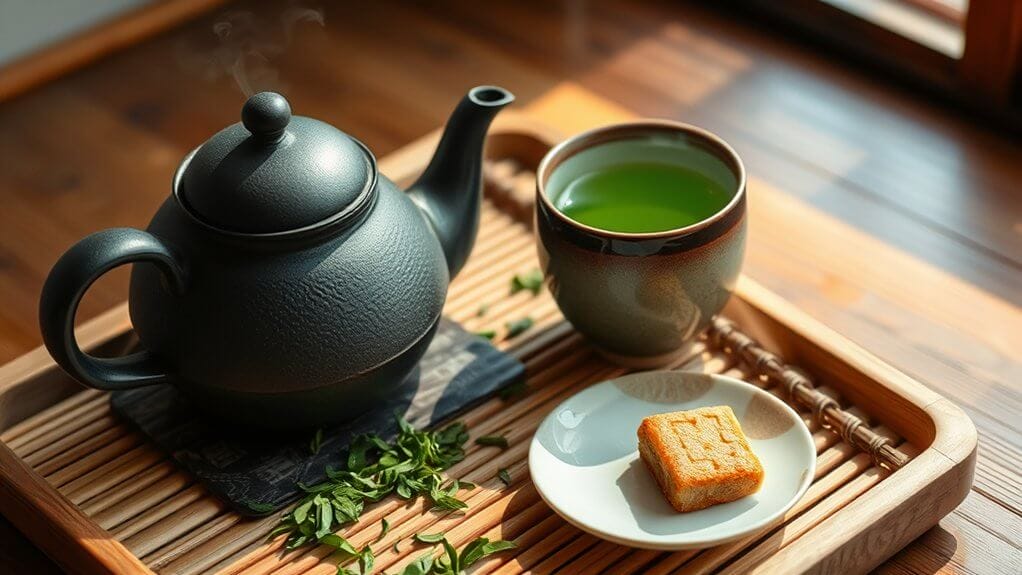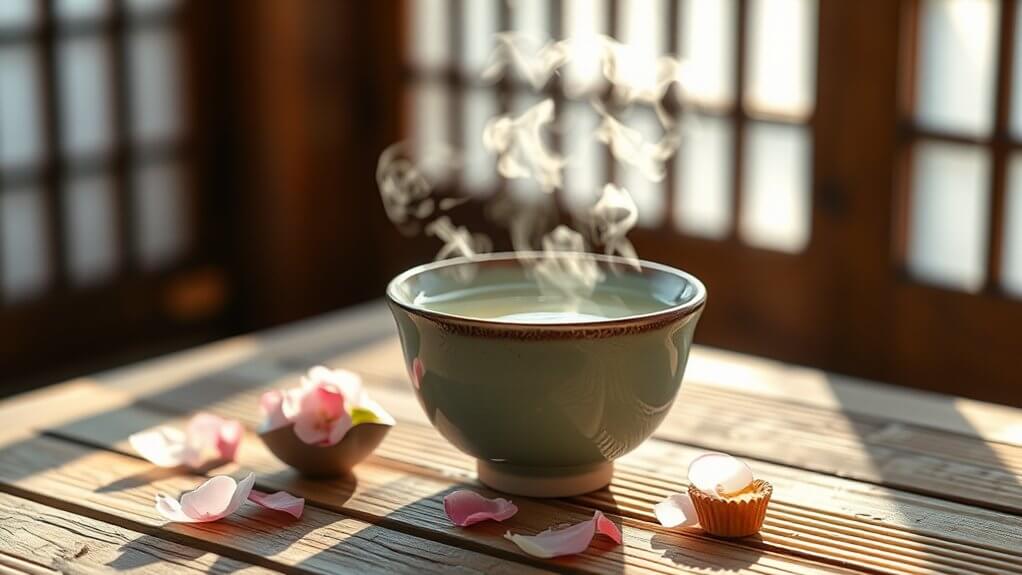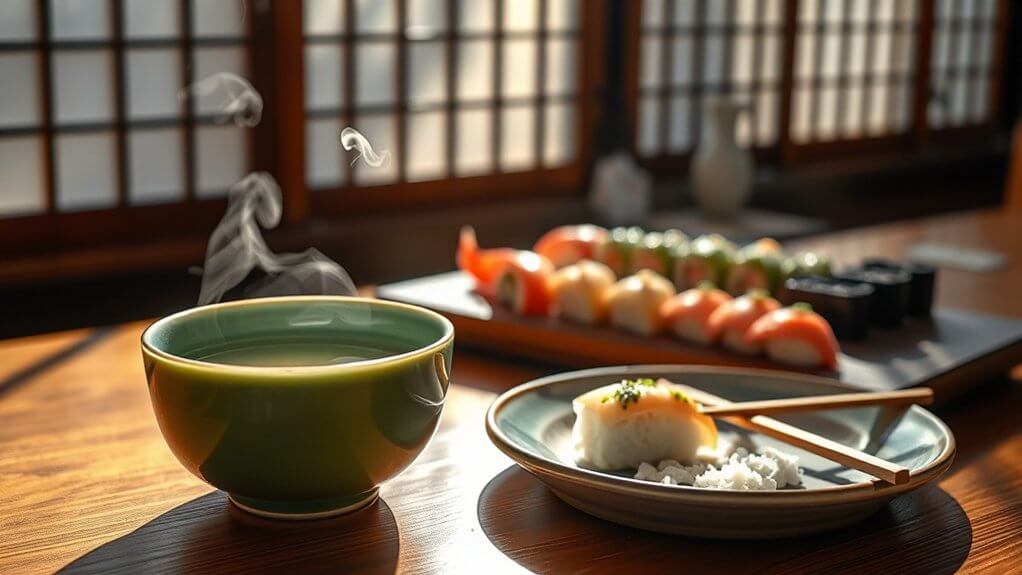The Japanese tradition of drinking green tea after meals offers more than cultural significance – it's backed by modern science. Studies show that green tea's catechins and antioxidants support digestion, suppress sugar absorption, and cleanse the mouth of food particles. Regular consumption can lower cholesterol, reduce stroke risk by 24%, and help prevent Type 2 diabetes complications. There's much more to discover about this ancient practice that's proving increasingly relevant in today's health-conscious world.
Key Points
- Green tea's catechins and antioxidants support digestive enzymes, making it an ideal post-meal beverage for better nutrient absorption.
- Japanese cultural tradition emphasizes drinking green tea after meals to promote mindfulness, harmony, and proper digestion.
- The beverage helps prevent blood sugar spikes by suppressing sugar absorption, particularly beneficial when consumed following meals.
- Green tea's antibacterial properties naturally cleanse the mouth of food particles, serving as a natural palate cleanser.
- The combination of L-theanine and catechins promotes relaxation and improved digestion while maintaining mental clarity after eating.
The Ancient Wisdom Behind Post-Meal Green Tea

While green tea has become a global phenomenon, its traditional role as a post-meal beverage in Japanese culture carries centuries of wisdom and purpose. The historical origins of this practice reflect a deep understanding of both physical wellness and social harmony, particularly in the context of Japanese culinary traditions. The consumption of green tea helps improve digestive health through its rich polyphenols that aid in breaking down food. Green tea effectively cleanses the palate after consuming foods like sushi and heavy meals. Research suggests that consuming tea after meals can boost immune function significantly. The custom extends beyond mere refreshment, serving as a dignified way to signal the conclusion of a meal while promoting digestive health through the tea's rich polyphenols. This practice has evolved into a sophisticated ritual, most significantly expressed in the Japanese tea ceremony, where every detail from tea selection to preparation embodies principles of respect, purity, and tranquility. The tradition continues to thrive today, with varieties like sencha and gyokuro offering both practical benefits and opportunities for meaningful social connection.
Scientific Evidence Supporting the Practice

Although traditional wisdom has long supported drinking green tea after meals, modern scientific research now validates this practice through extensive studies of the beverage's biological effects. Scientific studies have shown that green tea's catechins and antioxidants play a vital role in supporting digestive enzymes and promoting gastric juice secretion, particularly beneficial after heavy meals. This ancient practice originated in Zen temple culture, where strict regulations governed post-meal tea consumption. Experts recommend consuming at least three cups daily to maximize the potential health benefits.
While green tea can assist with digestion, timing of consumption is crucial for optimal benefits.
Key findings demonstrate that green tea:
- Suppresses sugar absorption, preventing sudden blood sugar spikes after eating
- Contains antibacterial properties that help cleanse the mouth of food particles
- Improves the intestinal environment while soothing the stomach
These benefits stem from green tea's rich antioxidant profile, particularly its catechins, which not only aid digestion but also contribute to overall gastrointestinal health. However, it's important to wait a short while after meals to avoid interference with iron absorption.
Cultural Significance in Japanese Society

Since its introduction from China in the 8th century, green tea has evolved into a cornerstone of Japanese culture, transcending its role as a mere beverage. The practice of serving tea after meals reflects deep-rooted cultural symbolism, emphasizing values of hospitality, purity, and harmony. The ancient practice was first established when Buddhist monks brought tea cultivation to Japan in the 12th century. These virtuous principles are exemplified through the four key elements of wa, kei, sei, and jaku, representing harmony, respect, purity, and elegance in tea consumption.
Japanese tea etiquette, whether in formal ceremonies or casual settings, demonstrates respect and mindfulness. In homes across Japan, the ritual of serving green tea to guests remains a powerful expression of welcome and consideration. The natural umami flavor of green tea creates a complementary finish to meals, making it an ideal post-dining beverage. The tea ceremony, known as chanoyu, epitomizes these principles through carefully choreographed movements and specific serving customs. From the use of traditional yunomi cups to the seasonal adaptation of serving temperatures, every aspect of green tea consumption carries cultural significance, making it an enduring symbol of Japanese heritage and social grace.
Health Benefits Beyond Digestion

The health benefits of green tea extend far beyond its digestive properties, encompassing remarkable effects on cardiovascular health, brain function, and cellular protection. Studies show it can lower cholesterol levels and reduce stroke risk by up to 24%, while its neuroprotective benefits help prevent cognitive decline and memory loss. Safe consumption levels allow for up to eight cups daily for most healthy adults. Regular consumption of green tea can dramatically reduce complications from Type 2 diabetes by as much as 40%. Traditional Japanese tea ceremonies demonstrate how mindful consumption can enhance the overall tea-drinking experience.
The combination of L-theanine and antioxidants offers multiple advantages:
- Promotes stress reduction while improving concentration and mood
- Helps maintain flexible blood vessels and ideal blood flow
- Guards against neurodegenerative diseases like Alzheimer's
Green tea's polyphenols and catechins also contribute to systemic health by reducing inflammation and fostering metabolic efficiency. For those seeking weight management solutions, regular consumption can enhance fat burning and help maintain a healthy weight, particularly when combined with its natural caffeine content.
Choosing the Right Green Tea Variety

Selecting an ideal green tea variety requires understanding three key categories: Japanese traditional teas, Japanese blends, and Chinese varieties. Among Japanese traditional tea types, gyokuro offers the richest umami flavor, while sencha provides a balanced taste that's perfect for daily drinking. Green tea's origins trace back to ancient Chinese traditions dating over 5000 years. For those seeking lower caffeine options, kukicha and bancha are excellent choices. At sushi restaurants, konacha is commonly served as a refreshing palate cleanser.
Japanese blends like genmaicha and houjicha cater to unique flavor preferences, with their toasty and smoky profiles respectively. For optimal brewing results, these teas should be prepared with water at 80°C (176°F). Those who enjoy floral notes might prefer Chinese varieties such as jasmine green tea or Bi Luo Chun. Longjing, with its chestnut hints and multiple infusion potential, remains a popular choice for tea enthusiasts who appreciate complexity in their brew.
Essential Brewing Techniques for Maximum Benefits

Mastering essential brewing techniques secures you'll extract the full potential of your green tea's flavor and health benefits. The brewing temperature plays a vital role, with premium varieties requiring 80-85°C water, while Japanese teas like Gyokuro need cooler temperatures around 60°C to prevent bitterness. Most teas can be steeped multiple times for additional servings while maintaining their distinct flavors. Many Japanese households keep hot water pots ready throughout the day for convenient brewing. A precise kitchen scale helps ensure consistent results with each brewing session.
The ideal steeping time varies by tea type, but most Japanese green teas reach their peak flavor in under a minute. For best results, use 3-5 grams of leaves per 200ml of water, and consider these key practices:
- Pre-warm your teaware to maintain consistent temperature
- Pour water directly onto the leaves using filtered water
- Avoid over-steeping, as it leads to bitterness rather than strength
Following these techniques guarantees a perfectly balanced cup that delivers both taste and wellness benefits.
The Art of Mindful Tea Drinking

While proper brewing techniques set the foundation, mindful tea drinking transforms a simple beverage into a profound sensory experience. The practice begins with mindful preparation, selecting tea that aligns with one's current state of mind. As water heats and steam rises, practitioners engage in sensory appreciation, noting the kettle's whispers and the tea's evolving aroma. Living in autopilot can disconnect us from these enriching moments, making mindful tea practices particularly valuable in modern life. The amino acid L-theanine in tea promotes a state of relaxation while maintaining mental clarity.
Cultural rituals, deeply rooted in Zen traditions, guide mindfulness practices through deliberate movements and focused attention. Through taste exploration and aroma exploration, drinkers discover intricate flavor profiles while maintaining present-moment awareness. Tea aesthetics play an essential role, from observing the liquid's color to feeling the cup's warmth. This approach, influenced by Japanese teaism, encourages practitioners to pause, breathe, and cultivate gratitude – turning each sip into a meditative moment that promotes both mental clarity and physical well-being. The practice helps quiet the mind as thoughts of past and future cease during these focused moments of appreciation.
Incorporating Green Tea Into Modern Dining Habits

As modern dining habits evolve, the ancient practice of drinking green tea after meals offers a practical bridge between tradition and contemporary wellness. Modern adaptations of this custom fit seamlessly into today's dining experiences, whether at home or in restaurants, providing both health benefits and cultural enrichment. The presence of theanine and catechin in green tea makes it particularly beneficial for post-meal consumption, supporting both relaxation and healthy digestion.
Today's busy lifestyles can accommodate green tea's traditional values through simple adjustments:
- Keep various green tea types at work or home for post-lunch relaxation
- Serve green tea as a sophisticated alternative to coffee after dinner parties
- Create a designated tea corner in the kitchen for mindful brewing moments
Conclusion
In a world obsessed with quick-fix digestive supplements and post-meal pills, it's ironically the simplest solution that's been hiding in plain sight for centuries. While modern society's rushing to create synthetic solutions, Japan's ancient practice of sipping green tea after meals continues to prove its worth through both scientific validation and cultural longevity. Perhaps the path to better digestion isn't found in modern innovation, but in ancient wisdom.




